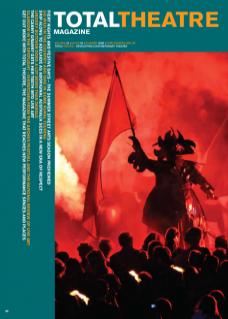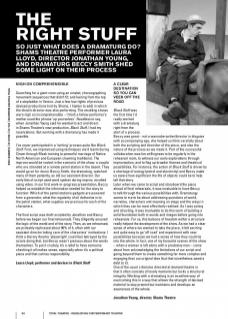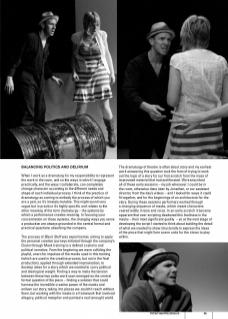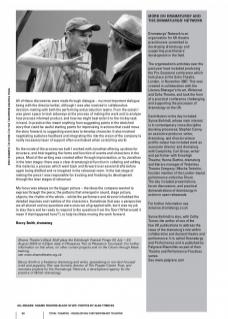NIGH ON COMPREHENSIBLE
Searching for a giant crow using an omelet; choreographing movement sequences that didn’t fit; and leering from the top of a stepladder in Venice. Just a few low-lights of previous devised productions (not by Shams, I hasten to add) in which the show’s director was also performing. The resulting shows were nigh on incomprehensible – I think a fellow performer’s mother used the phrase ‘up yourselves’. Needless to say, when Jonathan Young said he wanted to act and direct in Shams Theatre’s new production, Black Stuff, I had my reservations. But working with a dramaturg has made it possible.
I’ve never participated in a ‘writing’ process quite like Black Stuff. First, we improvised using techniques we’d learnt during Clown through Mask training (a powerful marriage of Native North American and European clowning traditions). The improvs would be rooted in the scenario of the show: a couple who are stranded at a remote petrol station in the desert. They would go on for hours. Beccy Smith, the dramaturg, watched many of them patiently, as did our assistant director. Our early bits of script used word spoken during improv, recalled using video. In our first work-in-progress presentation, Beccy helped us establish the information needed for the story to function: Which of the petrol station’s gadgets are powered from a generator; what the regularity of oil deliveries is to the petrol station; what supplies are precious for each of the characters.
The final script was draft-scripted by Jonathan and Beccy before we began our final rehearsals. They diligently ensured the logic of the world and of the story. Then, as we rehearsed, we probably rephrased about 90% of it, often with our assistant director taking care of the characters’ motivations. I think a literary theatre ‘playwright’ could feel betrayed by the actors doing that, but Beccy wasn’t precious about the words themselves. To put it crudely, it’s a relief to have someone checking it all makes sense, especially when it’s a political piece and that carries responsibility.
Laura Lloyd, performer and deviser in Black Stuff
A CLEAR DESTINATION SO YOU CAN VEER OFF THE ROAD
Black Stuff was the first time I’d really worked with a dramaturg right from the start of a process. Beccy was great – not a wannabe writer/director in disguise with accompanying ego, she helped us think carefully about both the scripting and direction of the piece, and also the nature of the process as we made it. Part of the successful collaboration was her willingness to be regularly in the rehearsal room, to witness our early explorations through improvisation, and to flag up broader themes and theatrical possibilities. For instance, the action of Black Stuff is driven by a shortage of energy (petrol and electricity) and Beccy made us aware how significant the life of objects could be to help tell that story.
Later when we came to script and storyboard the piece ahead of final rehearsals, it was invaluable to have Beccy to talk through the various possibilities with. Dramaturgy seems to me to be about addressing questions of world, narrative, characters and meaning on stage and the ways in which they can be most effectively realised. As I was acting and directing, it was invaluable to do this work of building a solid foundation both in words and images before going into rehearsals. For us, this balance of freedom within a structure really helped the development of the show. As we had a clear sense of where we wanted to take the piece, it felt exciting and quite easy to go ‘off road’ and experiment with new possibilities because we had a sense of how they could tie into the whole. In fact, one of my favourite scenes of the show – when a woman is left alone with a predatory man – came about from acknowledging the limitations of our script and going beyond them to create something far more complex and engaging than our original idea (but that nonetheless owed a debt to it).
One of the usual criticisms directed at devised theatre is that it often consists of lovely moments but lacks a structural integrity. Working with a dramaturg is an excellent way of overcoming this in a way that allows the strength of devised material to stay present but maintains and develops an awareness of the whole.
Jonathan Young, director, Shams Theatre
BALANCING POLITICS AND DELIRIUM
When I work as a dramaturg it’s my responsibility to represent the work in the room, and so the ways in which I engage practically, and the ways I collaborate, can completely change character according to the different needs and shape of each individual process. I think of the practice of dramaturgy as coming to embody the process of which you are a part, so it’s innately mutable. This might sound very vague but in practice it’s highly specific and relates to the other meaning of the term dramaturgy – the systems by which a performance creates meaning. In focusing your concentration on those systems, the changing ways you serve a production are always grounded in the central formal and practical questions absorbing the company.
The process of Black Stuff was experimental, aiming to apply the personal creative journeys initiated through the company’s Clown through Mask training to a defined scenario and political narrative. From the beginning we were colliding the playful, anarchic impulses of the masks used in this training (which are used in the creative process, but not in the final production), applied through extended improvisation, to develop ideas for a story which we needed to carry political and ideological weight. Finding a way to make the tension between these two poles work soon emerged as the central formal question of the piece – finding a solution that could harness the incredible creative power of the masks and enliven our story, taking it to places we couldn’t reach without them, but working with the masks in a framework that involved allegory, political metaphor and painted a real (enough) world.
The dramaturgy of theatre is often about story and my earliest work answering this question took the form of trying to work out the logic of a story for our first scratch from the mass of improvised material that had proliferated. We transcribed all of these early sessions – my job whenever I could be in the room, otherwise done later by Jonathan, or our assistant director, from the day’s videos – and I looked for ways it could fit together, and for the beginnings of an architecture for the story. During these sessions performers worked through a changing sequence of masks, which meant characters veered wildly in tone and voice. In an early scratch it became apparent that over-scripting deadened this liveliness in the masks – their most significant quality – so at the next stage of developing the script I started to think about building the detail of what we needed to show structurally to express the ideas of the piece that might form scene units for the clown to play within.
All of these discoveries were made through dialogue – my most important dialogue being with the director/writer, although I was also involved in collaborative decision-making with both the performing and production teams. From the outset I was given space to look sideways at the process of making the work and to analyse how process informed product, and how we might best tailor it to the tricksy task in hand. In practice this meant anything from suggesting points in the sketched story that could be useful starting points for improvising in actions that could move the story forward, to suggesting exercises to develop character. It also involved negotiating audience feedback and integrating this into the vision of the company (a really necessary layer of support often overlooked when scratching work).
On the inside of the process we built I worked with Jonathan offering up ideas for structure, and interrogating the forms and function of events and characters in the piece. Most of the writing was created either through improvisation, or by Jonathan in the later stages: there was a clear dramaturgical function in collating and editing this material, a process which went back and forward over several drafts before again being distilled and re-imagined in the rehearsal room. In the last stage of making the piece I was responsible for tracking and finalising its development through the later stages of rehearsal.
My focus was always on the bigger picture – the ideas the company wanted to express through the piece; the patterns that emerged in sound, stage picture, objects; the rhythm of the whole – whilst the performers and director inhabited the detailed impulses and realities of the characters. Sometimes that was a perspective we all shared and my questions were ones we all grappled with, but it was my job to stay there and be ready to respond to the questions from the floor (‘What would it mean if that happened here?’), to help facilitate moving the work forward.
Beccy Smith, dramaturg
MORE ON DRAMATURGY AND THE DRAMATURGS’ NETWORK
Dramaturgs’ Network is an organisation for UK theatre practitioners committed to developing dramaturgy and supporting practitioners’ development in the field.
The organisation’s activities over the past year have included producing the Pro-Sessional conference which took place at the Soho Theatre, London, in November 2007. This was created in collaboration with the Literary Manager’s forum, Writernet and Soho Theatre, and took the form of a practical conference challenging and supporting the processes of dramaturgy on the UK.
Contributors to the day included: Synne Behrndt, whose main interest is in contemporary cross-discipline devising processes; Stephen Canny, an executive producer, writer, dramaturg, and director whose prolific output has included work as associate director and dramaturg with Complicite; Carl Grose, writer and performer with Kneehigh Theatre; Hanna Slattne, dramaturg and literary manager of Tinderbox Theatre Company; Mischa Twitchin, founder member of the London-based performance collective Shunt. The day included presentations, forum discussions, and practical demonstrations of dramaturgy in action in open rehearsals.
For further information see www.ee.dramaturgy.co.uk
Synne Behrndt is also, with Cathy Turner, the author of one of the few UK publications to address the issue of the dramaturg’s role within collaborative and devised theatre and performance. It is called Dramaturgy and Performance and is published by Palgrave Macmillan as part of their Theatre and Performance Practices series.
See www.palgrave.com
Shams Theatre’s Black Stuff plays the Edinburgh Festival Fringe 30 July – 25 August 2008 at 4.20pm daily in Pleasance Two at Pleasance Courtyard. For further information on this show, on other current projects and on the Clown through Mask training, see www.shamstheatre.org.uk
Beccy Smith is a freelance dramaturg and writer, specialising in non-text focused work and puppetry. She was formerly director of The Puppet Centre Trust, and oversees projects for the Dramaturgs’ Network, a development agency for the practice of British dramaturgy.



